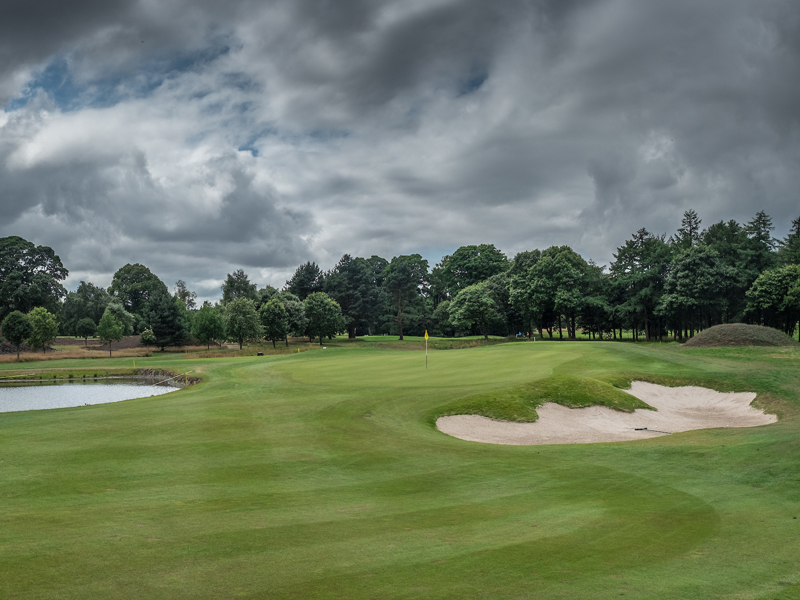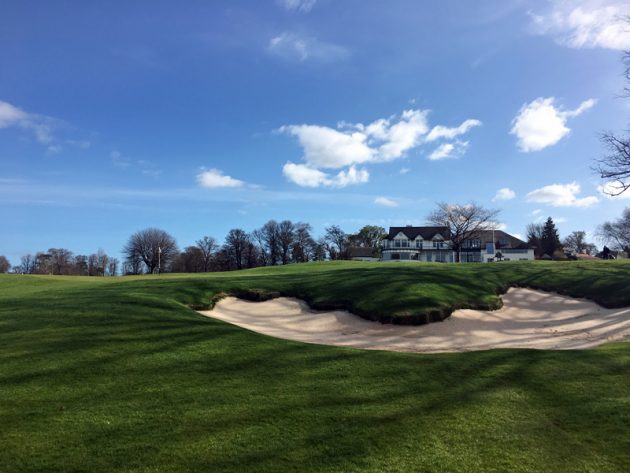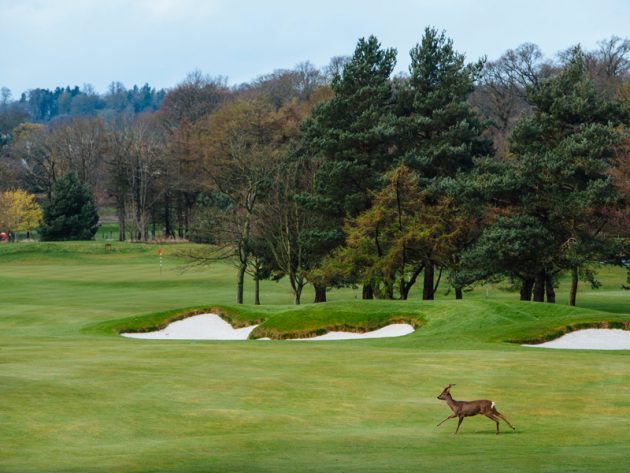Moving with the times - Impressive changes at Bruntsfield Links
Fergus Bisset went to view changes to the course at Bruntsfield Link


Fergus Bisset was invited to Bruntsfield Links Golfing Society in Edinburgh to view the recently completed, ambitious and impressive course re-development programme that has taken place there.
Moving with the times - Impressive changes at Bruntsfield Links
Bruntsfield Links Golfing Society is one of Scotland’s great and historic golfing bodies.
In fact, The Society is the fourth oldest club in the world, with a heritage that can be traced back to the organisation’s origins in 1761.
The Society moved to its current site three miles west of Edinburgh city centre, an attractive tract of parkland looking out towards the Firth of Forth, in 1898 where twice Open Champion Willie Park Jnr laid out a course.
The list of the architects involved in the evolution of the layout at Bruntsfield Links makes for impressive reading.
Following Park’s initial design, Dr Alister MacKenzie (he of Augusta fame) was employed to oversee improvements in 1922 and then James Braid added further touches in 1930. During the 1970s, Fred Hawtree also oversaw work at Bruntsfield.
Get the Golf Monthly Newsletter
Subscribe to the Golf Monthly newsletter to stay up to date with all the latest tour news, equipment news, reviews, head-to-heads and buyer’s guides from our team of experienced experts.
The quality of the layout has been recognised over the years by the fact The Society has played host to a number of prestigious competitions, including: The British Seniors Amateur Championship, of 1998, the Scottish Strokeplay Championship of 1992 and recently Regional Qualifying for the 2011-2015 Open Championships.
When The Society decided then to undergo further significant works to the course in 2016, it was fitting that leading architects Mackenzie & Ebert were selected through a tender process and given the task of overseeing the works.
Having completed work on seven of the courses on The Open rota, Mackenzie and Ebert’s objective at Bruntsfield was to restore the playing characteristics established by Dr Alister MacKenzie in the 1920s, with particular attention to be paid to the bunkering.
The £1.2 million project has been carried out in two phases over 2017 and 2018 and was completed in such a way that play was continuous through this time.
Before heading down to Edinburgh, I had learned that the project was completed on time, slightly under budget and that the course was playable again long before it was generally expected to be. That sounded to me like a pretty reasonable result.
I last played at Bruntsfield Links 10 years ago and had been highly impressed by the inland layout at that time. I was interested to see the alterations and the effect they have had on the feel and playability of the course.
First thing to say, before getting into the details on the course layout and redesign is that the feel and atmosphere at this tremendous city club has, thankfully, not changed from what I remembered.
From the moment one arrives at the elegant and comfortable clubhouse there’s a great sense of relaxed confidence about the place.
The quality of every aspect, from locker room to members’ lounge, pro shop to practice ground, is quite clear but it’s refined and quietly spoken.
It’s what you might expect from a society that has had 250+ years to get it just right.

Out on, and around the course, there’s a wonderful feeling of seclusion and tranquillity to be found. Set over 150 acres, this is a large swathe of parkland and it’s very easy to forget that the city is just a short drive away, and that urbanisation exists all around.
One of the great features on the course is the tremendous selection of trees surrounding, lining and framing the holes. The variety of shapes and colours these deciduous and coniferous trees provide creates a wonderful backdrop.
And, of course, they are a haven for wildlife: A recent survey discovered no fewer than 38 species of birds in the sectors reviewed.
To the course then in more detail. Standing on the 1st tee the immediate thing to strike me was the obvious aesthetic improvement of the remodelled bunkering.
Designed to recreate what Alister MacKenzie envisaged in the 1920s, the bunkers are a real feature now, right through the course.
They’re not overly deep and are generally very playable, but they’re elegantly sculpted and cleverly fingered to create appealing and attractive shapes. They look superb.
Right from the 1st, it’s also clear that the hazards are well-placed to deliver a more strategic examination from the tee.
An objective for the architect was to make sure the test at Bruntsfield is commensurate with the modern game, and they have succeeded in that aim.
The examination is definitely more strategic than last time I played – driver isn’t always the correct choice from the tee and playing for position, and avoiding sand is key.
Around the greens, a number of new green complexes have been established through the two phases and these undoubtedly deliver a fairer test than previously.
The work has been done cleverly and subtly and, in fact, it’s quite incredible that there is almost no evidence of the disruption there must have been, so soon after its completion.
In certain areas around the course, wispy grasses have been allowed to grow up providing great definition and, for me, this delivers just a feel of the heath that I think works really rather well, particularly where the pine trees are prevalent.

The shaping of some holes has been altered to improve the angles for both drive and approach and, again, these subtle changes have definitely heightened the challenge posed by the course.
I was particularly struck by alterations to the 9th hole. Previously it was a fairly straightforward par-4 up the hill, measuring just under 350 yards.
Now it’s a brilliant par-5 that wraps around the edge of Bruntsfield’s famous quarry, turning right to left.
It demands a drive to the right side, a lay-up into optimum position and a deft short shot to a raised green.
The 10th is now a very attractive par-3 with views of the Firth of Forth behind a long, narrow green that allows the hole to be stretched anywhere from just over 100 yards to nigh-on 170 yards.
Back-to-back par 5s at the 12th and 13th are both great fun to play and offer risk/reward opportunities.
The final stretch has been enhanced. There’s a new par-3 at the 16th, protected by a water-hazard to the left side, then the 17th is a challenging par-4 requiring two solid blows.
The last hole epitomises the revamped challenge at Bruntsfield. It may only be 340-yards, but bunkers wait at driving distance. A lay-up is required, asking for a tricky final shot to a subtly sloping green protected by more sand just short of the surface.
It’s a great strategic test and that pretty much sums up what has been created by Tom Mackenzie and The Bruntsfield Links Golfing Society through this project.
They have taken an already excellent inland course and carefully and cleverly remodelled it to maximise the golfing offering on this fine piece of expansive parkland.
The new bunkering is a triumph and the re-routing has created a selection of interesting and testing holes.
The Bruntsfield Links Golfing Society is rightly proud of its history and of the great architects who have shaped their lovely course over the last 120 years. Tom Mackenzie has been able to keep a close eye on that heritage while moving the layout strongly and confidently into line with the modern game.

Fergus is Golf Monthly's resident expert on the history of the game and has written extensively on that subject. He has also worked with Golf Monthly to produce a podcast series. Called 18 Majors: The Golf History Show it offers new and in-depth perspectives on some of the most important moments in golf's long history. You can find all the details about it here.
He is a golf obsessive and 1-handicapper. Growing up in the North East of Scotland, golf runs through his veins and his passion for the sport was bolstered during his time at St Andrews university studying history. He went on to earn a post graduate diploma from the London School of Journalism. Fergus has worked for Golf Monthly since 2004 and has written two books on the game; "Great Golf Debates" together with Jezz Ellwood of Golf Monthly and the history section of "The Ultimate Golf Book" together with Neil Tappin , also of Golf Monthly.
Fergus once shanked a ball from just over Granny Clark's Wynd on the 18th of the Old Course that struck the St Andrews Golf Club and rebounded into the Valley of Sin, from where he saved par. Who says there's no golfing god?
-
 Could This 'Stumbled Upon' Equipment Switch Finally Land Rory McIlroy the Grand Slam?
Could This 'Stumbled Upon' Equipment Switch Finally Land Rory McIlroy the Grand Slam?Rory McIlroy made a golf ball change earlier this season that has reignited his wedge play and it could be about to pay off in the most dramatic possible way…
By Joe Ferguson Published
-
 The Masters Final Round: TV Coverage, Live Streams, Start Times As Rory McIlroy Battles Bryson DeChambeau And History
The Masters Final Round: TV Coverage, Live Streams, Start Times As Rory McIlroy Battles Bryson DeChambeau And HistoryAll the info on live streams, TV broadcasts, and free coverage of one of the most hotly anticipated final days of any Major as McIlroy battles with DeChambeau
By Patrick Fletcher Published